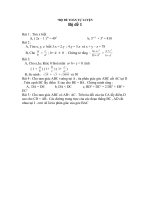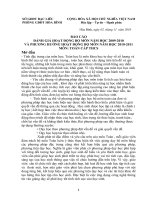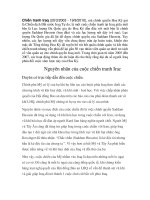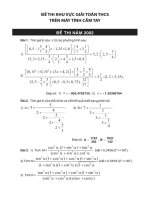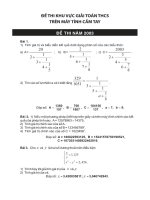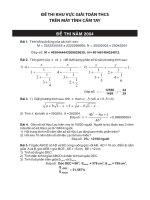ratios and rates grade 7 Bộ Sách Toán THCS Của Mỹ
Bạn đang xem bản rút gọn của tài liệu. Xem và tải ngay bản đầy đủ của tài liệu tại đây (4.64 MB, 68 trang )
Ratios
and Rates
Number
CuuDuongThanCong.com
/>
Mathematics in Context is a comprehensive curriculum for the middle grades.
It was developed in 1991 through 1997 in collaboration with the Wisconsin Center
for Education Research, School of Education, University of Wisconsin-Madison and
the Freudenthal Institute at the University of Utrecht, The Netherlands, with the
support of the National Science Foundation Grant No. 9054928.
The revision of the curriculum was carried out in 2003 through 2005, with the
support of the National Science Foundation Grant No. ESI 0137414.
National Science Foundation
Opinions expressed are those of the authors
and not necessarily those of the Foundation.
Keijzer, R., Abels, M., Wijers, M., Brinker, L. J., Shew, J. A., Cole, B. R., and
Pligge, M. A. (2006). Ratios and rates. In Wisconsin Center for Education
Research & Freudenthal Institute (Eds.), Mathematics in Context. Chicago:
Encyclopædia Britannica, Inc.
Copyright © 2006 Encyclopædia Britannica, Inc.
All rights reserved.
Printed in the United States of America.
This work is protected under current U.S. copyright laws, and the performance,
display, and other applicable uses of it are governed by those laws. Any uses not
in conformity with the U.S. copyright statute are prohibited without our express
written permission, including but not limited to duplication, adaptation, and
transmission by television or other devices or processes. For more information
regarding a license, write Encyclopædia Britannica, Inc., 331 North LaSalle Street,
Chicago, Illinois 60610.
ISBN 0-03-039629-8
2 3 4 5 6 073 09 08 07 06
CuuDuongThanCong.com
/>
The Mathematics in Context Development Team
Development 1991–1997
The initial version of Ratios and Rates was developed by Ronald Keijzer and Mieke Abels.
It was adapted for use in American schools by Laura J. Brinker, Julia A. Shew, and Beth R. Cole.
Wisconsin Center for Education
Freudenthal Institute Staff
Research Staff
Thomas A. Romberg
Joan Daniels Pedro
Jan de Lange
Director
Assistant to the Director
Director
Gail Burrill
Margaret R. Meyer
Els Feijs
Martin van Reeuwijk
Coordinator
Coordinator
Coordinator
Coordinator
Sherian Foster
James A, Middleton
Jasmina Milinkovic
Margaret A. Pligge
Mary C. Shafer
Julia A. Shew
Aaron N. Simon
Marvin Smith
Stephanie Z. Smith
Mary S. Spence
Mieke Abels
Nina Boswinkel
Frans van Galen
Koeno Gravemeijer
Marja van den
Heuvel-Panhuizen
Jan Auke de Jong
Vincent Jonker
Ronald Keijzer
Martin Kindt
Jansie Niehaus
Nanda Querelle
Anton Roodhardt
Leen Streefland
Adri Treffers
Monica Wijers
Astrid de Wild
Project Staff
Jonathan Brendefur
Laura Brinker
James Browne
Jack Burrill
Rose Byrd
Peter Christiansen
Barbara Clarke
Doug Clarke
Beth R. Cole
Fae Dremock
Mary Ann Fix
Revision 2003–2005
The revised version of Ratios and Rates was developed by Mieke Abels and Monica Wijers.
It was adapted for use in American schools by Margaret A. Pligge.
Wisconsin Center for Education
Freudenthal Institute Staff
Research Staff
Thomas A. Romberg
David C. Webb
Jan de Lange
Truus Dekker
Director
Coordinator
Director
Coordinator
Gail Burrill
Margaret A. Pligge
Mieke Abels
Monica Wijers
Editorial Coordinator
Editorial Coordinator
Content Coordinator
Content Coordinator
Margaret R. Meyer
Anne Park
Bryna Rappaport
Kathleen A. Steele
Ana C. Stephens
Candace Ulmer
Jill Vettrus
Arthur Bakker
Peter Boon
Els Feijs
Dédé de Haan
Martin Kindt
Nathalie Kuijpers
Huub Nilwik
Sonia Palha
Nanda Querelle
Martin van Reeuwijk
Project Staff
Sarah Ailts
Beth R. Cole
Erin Hazlett
Teri Hedges
Karen Hoiberg
Carrie Johnson
Jean Krusi
Elaine McGrath
CuuDuongThanCong.com
/>
(c) 2006 Encyclopædia Britannica, Inc. Mathematics in Context and the
Mathematics in Context Logo are registered trademarks of Encyclopædia
Britannica, Inc.
Cover photo credits: (all) © Getty Images
Illustrations
12, 14–16, 20 © Encyclopædia Britannica, Inc.; 19, 22, 23, 32 Holly Cooper-Olds;
36, 37, 40, 53 Michael Nutter/© Encyclopædia Britannica, Inc.; 54 Christine
McCabe/© Encyclopædia Britannica, Inc.
Photographs
1 (top) Gary Russ/HRW Photo; (bottom) Victoria Smith/HRW; 2 HRW Photo/
Sam Dudgeon; 4–6 Victoria Smith/HRW; 11 (top to bottom) © Corbis; © Corbis;
© PhotoDisc/Getty Images; © Corbis; 16 (left to right) © Corbis; © Corbis;
John A. Rizzo/PhotoDisc/Getty Images; © Corbis; 21 Dennis MacDonald/Alamy;
22 © Corbis; 25 (left to right) PhotoDisc/Getty Images; © Corbis; 27 PhotoDisc/
Getty Images; 30 Sam Dudgeon/HRW; 35 (top) Jim Vogel; (bottom) Kalmbach
Publishing Co. collection; 39 © Corbis; 41 (left to right) © Digital Vision/
Getty Images; PhotoDisc/GettyImages; 42 (top, bottom) © Corel; (middle) Dynamic
Graphics Group/Creatas /Alamy; 43 (top) James F. Snyder; (bottom) Artville/Getty
Images; 45 (left to right) © Corbis; Georgette Douwma/PhotoDisc/Getty Images;
Russell Illig/PhotoDisc/Getty Images; 47 (top) Su Davies/PhotoDisc/Getty Images;
(bottom) PhotoDisc/Getty Images; 49 Artville/Getty Images; 54 Andrew Ward/
Life File/PhotoDisc/Getty Images
CuuDuongThanCong.com
/>
Contents
Letter to the Student
Section A
Single Number Ratios
Car Pooling?
Miles per Gallon
Miles per Hour
Cruise Control
Summary
Check Your Work
Section B
21
23
25
28
29
Scale and Ratio
Scale Drawings
Scale Models
Maps
Summary
Check Your Work
Section E
11
15
16
18
19
Different Kinds of Ratios
Too Fast
Percent
Part-Part and Part-Whole
Summary
Check Your Work
Section D
1
4
6
7
8
9
Comparisons
Telephones and Populations
Television Sets
Cell Phones
Summary
Check Your Work
Section C
vi
30
35
36
38
39
Scale Factor
Smaller or Larger
Enlarged or Reduced
Summary
Check Your Work
41
43
48
49
Additional Practice
50
Answers to Check Your Work
55
Contents v
CuuDuongThanCong.com
/>
Dear Student,
Welcome to the unit Ratios and Rates. In this unit you will learn many
different ways to make comparisons.
Do you have more boys or girls in your class? If you count, you might
use a ratio to describe this situation. You can make comparisons
using different types of ratios.
You might have noticed speed limit signs posted
along highways and streets. The rate a car travels
on a highway is usually greater than the rate a
car travels on a street. You can make comparisons
using rates.
You use ratios to make scale drawings.
Architects use scale drawings to design
and build buildings. They create sets of
working documents, which contain a
floor plan, site plan, and elevation plan.
Maps are also scale drawings.
Have you ever looked at a cell through a microscope?
The magnification of the lens sets the ratio between
what you see and the actual size of the cell.
Architects, engineers, and artists often make scale models of objects
they want to construct. Many people have hobbies creating miniature
worlds using trains, planes, ships, and automobiles. When you look
through a microscope, you see enlargements of small objects.
In all instances, ratios keep everything real. We hope you learn efficient
ways to work with ratios and rates.
Sincerely,
The Mathematics in Context Development Team
vi Ratios and Rates
CuuDuongThanCong.com
/>
A
Single Number Ratios
Car Pooling?
The students in Ms. Cole’s science class are concerned about the
air quality around Brooks Middle School. They noticed that smog
frequently hangs over the area. They just finished a science project
where they investigated the ways smog destroys plants, corrodes
buildings and statues, and causes respiratory problems.
The students hypothesize that the city has so much smog because
of the high number of cars on the roads. Students think there are so
many cars because most people do not carpool. They want to find
out if people carpool.
They set up an experiment to
count the number of cars and
people on the East Side Highway
adjacent to the school.
Section A: Single Number Ratios 1
CuuDuongThanCong.com
/>
A Single Number Ratios
One group spent exactly one minute and counted 10 cars and
12 people.
1. a. How many of these cars could have carried more than one
person? Give all possible answers.
b. Find the average number of people per car and explain how
you found your answer.
At the same time, at a different point on the highway, a second group
of students counts cars and people for two minutes. A third group
counts cars and people for three minutes.
The second and third groups each calculate the average number of
people per car. They are surprised to find that both groups got an
average of 1.2 people per car.
2. How many cars and how many people might each group have
counted?
2 Ratios and Rates
CuuDuongThanCong.com
/>
Single Number Ratios A
A fourth group counts cars and people for one minute on the north
side of the school. They count 18 cars and 21 people.
3. Compare the results of the fourth group of students with those of
the other three groups. What conclusions can you draw?
For the first group of students, the ratio of people to cars was
12 people to 10 cars or 12:10. Another way to describe this is it to
use the average number of people per car. The first three groups
calculated an average of 1.2 people per car. They might have found
this average by calculating the result of the division 12 ، 10.
You can show both the ratio and the average in a ratio table.
Number of People
12
1.2
Number of Cars
10
1
4. a. How can you use the ratio table to find the average number of
people per car?
b. You can also write the average number of people per car in a
ratio. What ratio is this?
c. Given this average, how many people would you expect to see
if you counted 15 cars?
d. What can you say about the number of people in each of the
15 cars?
In order to lessen air pollution, the students investigate ways to
increase the average number of people per car.
5. Explain why a higher average of people per car will result in
fewer cars. You may use examples in your explanation.
Section A: Single Number Ratios 3
CuuDuongThanCong.com
/>
A Single Number Ratios
Some students recommend that the average number of people per
car should increase from 1.2 to 1.5 people per car.
6. a. Find 5 different groups of cars and people that will give you an
average of 1.5 people per car. Put your findings in a table.
b. Work with a group of your classmates to make a poster that
will show the city council how raising the average number of
people per car from 1.2 to 1.5 will lessen traffic congestion and
improve the quality of air.
Miles per Gallon
Another way to reduce air pollution is to encourage drivers to use
automobiles that are more efficient. A local TV station decides to
do a special series on how to reduce air pollution.
In one report, the newscaster mentions, “Cars with high gas mileage
pollute less than cars with low gas mileage.”
Gas mileage is the average number of miles (mi) a car can travel on
1 gallon (gal) of gasoline. It is represented by the ratio of miles per
gallon (mpg).
John says, “My car’s gas mileage is 25 mpg.”
7. How many miles can John travel on 12 gal of gas?
4 Ratios and Rates
CuuDuongThanCong.com
/>
Single Number Ratios A
Cindy, Arturo, and Sheena see the report on TV. They decide to
calculate their gas mileage to see whose car pollutes the least.
Cindy remembers that she drove 50 mi on 2.5 gal of gasoline.
She creates the following ratio table on a scrap paper.
Miles
Gallons
50
2.5
100
5
20
1
Cindy says, “My gas mileage is 20 mpg.”
8. Explain Cindy’s calculation and answer.
The last time Arturo filled up his car, he
had driven 203 mi on 8.75 gal of gas.
9. Explain whether Arturo’s gas
mileage will be more or less than
Cindy’s gas mileage.
Arturo set up this ratio table to calculate his gas mileage.
Number of Miles
203
2,030
20,300
Number of Gallons
8.75
87.5
875
10. a. What did Arturo do in his ratio table to make the number of
gallons a whole number?
b. Calculate Arturo ’s gas mileage.
Sheena traveled 81.2 mi on 3.75 gal of gas.
11. Compare the gas mileage of Sheena’s, Arturo ’s and Cindy’s cars.
What conclusions can you draw?
Section A: Single Number Ratios 5
CuuDuongThanCong.com
/>
A Single Number Ratios
Miles per Hour
It took Sheena 2 hours to travel 81.2 mi. Sheena used a ratio table
to calculate the average number of miles she drove per hour. Here
is Sheena’s scrap of paper.
Miles
Hours
81.2
2
812
20
406
10
40.6
1
12. a. Explain Sheena’s calculation method.
b. What is the average number of miles Sheena drove per hour?
c. How would you calculate the average number of miles per
hour for Sheena?
The average number of miles per hour is
called the average speed. Average speed
is expressed in miles per hour (mi/h).
Average speed is expressed as a
single number.
6 Ratios and Rates
CuuDuongThanCong.com
/>
Single Number Ratios A
Consider for example that Cindy traveled at an average speed of
55 mi/h. An average speed of 55 mi/h is the ratio 55:1, read as
“fifty-five to one.” This ratio can be written in a ratio table like
the one for problem 12.
13. Reflect. Describe another situation where the average is a ratio
expressed as a single number.
Nick traveled 72 miles to Lincoln, Nebraska.
He departed at 8:00 A.M. and arrived at 9:30 A.M.
Kendra traveled 140 mi to Louisville, Kentucky.
She departed at 2:00 P.M. and arrived at 5:20 P.M.
14. Who traveled at a higher average speed, Nick or Kendra?
(Hint: Ratio tables can be very useful to solve this problem.)
Cruise Control
Many modern cars are equipped with cruise control, which allows
the driver to set the car’s speed to be constant. This makes highway
driving easier and saves gas. Sheena used this feature to take two
trips.
On Monday, Sheena drove from 1:00 P.M. until 2:30 P.M. with a
constant average speed of 48 mi/h.
15. How far did Sheena drive on Monday?
(Hint: Ratio tables can be very useful to solve this problem.)
On Tuesday, Sheena drove from 9:00 A.M. until 9:45 A.M. with the
cruise control set at the same average speed of 48 mi/h.
16. What is Sheena’s distance for Tuesday’s trip?
Sheena’s gas mileage was 24 mpg for both trips.
17. How many gallons of gas did she use on these trips?
Section A: Single Number Ratios 7
CuuDuongThanCong.com
/>
A Single Number Ratios
You can use ratios to express relationships.
The ratio of girls to boys in one class is 15 :12.
The ratio of people to cars at one corner is 14 :10.
You can write ratios as single numbers to express averages.
On average, in one class there are 1.25 girls for every boy.
On average, at one corner there were about 1.4 people per car.
To write ratios as single numbers, you may use ratio tables.
Average gas mileage
Karla drove 75 mi on 2.5 gal of gas. What is her gas mileage?
؋ 10
، 25
Number of Miles
75
750
30
Number of Gallons
2.5
25
1
؋ 10
، 25
The ratio 75 : 2.5 is the same as 30 :1. This ratio means that for this trip,
Karla averaged 30 miles per gallon. Her gas mileage was 30 mpg.
•
To write ratios as single numbers, you may also use division.
75 mi ، 2.5 gal = 30 mpg.
Using a ratio as a single number to express an average makes it easy
to compare different situations. Here is an example.
•
Comparing average speed (mi/h)
It took Serena 2 hr to drive 90 mi. Karla drove 75 mi in 1.5 hr.
Compare their average speed.
•
Using ratio tables:
Serena’s trip
Number of Miles
90
45
Number of Hours
2
1
8 Ratios and Rates
CuuDuongThanCong.com
/>
Karla’s trip
Number of Miles
75
150
50
Number of Hours
1.5
3
1
Serena averaged 45 mi/h. Serena’s average speed was 45 mi/h.
Karla averaged 50 mi/h. Karla’s average speed was 50 mi/h.
So Karla drove faster.
1. a. Find the average number of people per car if you counted
16 cars and 40 people.
b. Find the average number of students per class if there are
320 students in 9 classes.
2. Use a ratio table to calculate the gas mileage.
A car travels 108 mi on 6 gal of gas.
Number of Miles
Gallons of Gas
Section A: Single Number Ratios 9
CuuDuongThanCong.com
/>
A Single Number Ratios
Martha had her car repaired at a garage. Shown below is part of the
bill she received from her mechanic.
Village Automotive
Parts
Labor
Total
None
1.5 hr
$90.00
3. Use the following ratio table to find how much her mechanic
charged per hour.
Cost in Dollars
Number of Hours
David and his group counted cars and people.
The ratio of people to cars is 25 :15.
4. Write this ratio as a single number to express the average
number of people per car.
5. Make up your own problem about ratios and averages.
Of course, you will have to provide an answer to your
problem as well.
Describe how you would explain to a car owner the way to calculate
gas mileage.
10 Ratios and Rates
CuuDuongThanCong.com
/>
B
Comparisons
Telephones and Populations
The table below shows the population and the total number of
telephones for 15 different countries.
Country
Population
Number of Telephones
Bolivia
8.4 million
1.26 million
Chad
9.0 million
44,000
China
1.3 billion
430.50 million
Cuba
11.2 million
580,700
Finland
5.2 million
6.3 million
France
59.8 million
73 million
Hungary
10.1 million
10.1 million
India
1.05 billion
54.6 million
Japan
127 million
150.82 million
Tonga
102,000
14,500
Micronesia
112,000
60,000
Solomon Islands
450,000
7,600
South Africa
45.3 million
17.17 million
Sudan
38.1 million
872,000
United States
292.6 million
331 million
Source: Encyclopaedia Britannica Almanac, 2005 (Chicago: Encyclopaedia Britannica, Inc. 2005)
1. According to the data, which countries in the table have more
telephones than people?
Section B: Comparisons 11
CuuDuongThanCong.com
/>
B Comparisons
Joan looks at the numbers in the table and says, “the United States
has the largest population because 292.6 is the highest number
before the million.”
Brian disagrees; he says that the population of China is larger.
2. Explain who is right.
3. a. Based on the data in the table, in which countries do you
think people rely the most on the use of telephones for
communication? Explain.
b. In which countries did people rely less on the use of
telephones for communication?
MICRONESIA
The data table on page 11 shows that Micronesia has 60,000
telephones and a population of 112,000 people. The ratio of
people to telephones is 112,000:60,000.
Number of People
112,000
.......
Number of Telephones
60,000
1
12 Ratios and Rates
CuuDuongThanCong.com
/>
Comparisons B
4. a. Do you think it is true that in Micronesia everybody has a
phone? Explain your thinking.
b. Use the ratio table on page 12 to find the average number of
people per telephone in Micronesia.
c. Is the average number of people per telephone in Tonga
greater or smaller than in Micronesia? Explain how you
found your answer.
In problem 4, you found the average number of people per telephone
in Micronesia. This number tells you how many people would share
one telephone.
It is also possible to look at the ratio of telephones to people. For
Micronesia, this ratio is 60,000:112,000.
5. a. Use this ratio to calculate the average number of telephones
per person.
b. Reflect Which number do you find the most useful to tell
something about the use of telephones in a country—the
number of people per telephone or the number of
telephones per person? Explain your choice.
If you compare countries with respect to the number of telephones
without considering the number of people living in these countries,
the comparison is an absolute comparison.
If you compare countries with respect to the number of telephones
and consider the number of people living in these countries, the
comparison is a relative comparison, comparing telephones per
person.
Section B: Comparisons 13
CuuDuongThanCong.com
/>
B Comparisons
FINLAND
CHINA
Consider the data for China and Finland.
6. a. Use an absolute comparison to answer.
Which of these countries had more telephones?
b. Use a relative comparison to answer.
Which of these countries had more telephones per person?
You may use the ratio tables set up below.
Finland
Number of Telephones (in millions)
6.3
Population
5.2
(in millions)
1
China
Number of Telephones (in millions)
430.50
Population
1,300
(in millions)
7. Which of the comparisons between China and Finland, the
absolute comparison or the relative comparison, do you
think gives a better picture of the number of telephones
in these countries? Why?
8. Reflect. When would an absolute comparison be most useful?
When would a relative comparison be a better choice?
14 Ratios and Rates
CuuDuongThanCong.com
/>
Comparisons B
Television Sets
CANADA
FRANCE
BRAZIL
TV Sets
there are 317 TVs
Brazil has about 176 million people, and
e are about
for every 1,000 citizens. For Canada, ther
y 1,000 citizens.
ever
for
TVs
31.9 million people and 708
606 TVs for every
and
ple
France has about 59.7 million peo
1,000 citizens.
The paragraph on the left is
from a paper Brian wrote that
compares the numbers of
television sets in several of
the world’s countries.
9. a. What information could Brian have used to calculate that there
were 708 TV sets per 1,000 Canadians?
b. Can you determine the number of TV sets for each Canadian?
Explain your answer.
c. What is the total number of TVs in Canada? Explain how you
found your answer.
10. a. Find the total number of TVs for Brazil.
b. Find the total number of TVs in France.
Section B: Comparisons 15
CuuDuongThanCong.com
/>
B Comparisons
Cell Phones
Since the 1990s, more and more people all over the world have cell
phones.
The table shows the number of cell phones per 1,000 people in the
year 2001 for some countries and for the world.
Denmark
United
States
Canada
Taiwan
Poland
World
740
440
320
970
260
160
Number of Cell
Phones per 1,000
People
CANADA
DENMARK
POLAND
TAIWAN
UNITED
STATES
16 Ratios and Rates
CuuDuongThanCong.com
/>
Comparisons B
11. a. Can you conclude from the table that there are more cell
phones in Denmark than in Canada? Explain your answer.
b. What information do you need to be able to calculate the
number of cell phones in the U.S.?
c. In Taiwan, the number of cell phones per person is
approximately 1.0. Explain how this number is calculated.
d. Select two other countries in the table and find the average
number of cell phones per person. How do these countries
compare to the world average?
Math History
Ratios and Music
do
re
mi
la
sol
la
ti
do
C
D
E
F
G
A
B
C
Pythagoras (around 500 B.C.) was a Greek mathematician, teacher,
and philosopher. He found a relationship between ratios and the
musical scale as a result of his experiments with a monochord, a one
string musical instrument. He found that the shorter the string, the
higher the pitch. A movable bridge could make the string shorter.
Here you see the ratio 3 :2 between the lower C (do) and the G (sol).
(3)
do
(2)
Movable bridge
The other ratios are
C (do) 1:1
G (sol) 3:2
D (re) 9: 8
A (la) 5: 3
E (mi) 5 :4
B (te) 15 : 8
F (fa) 4 : 3
C (do) 2 :1
Section B: Comparisons 17
CuuDuongThanCong.com
/>
B Comparisons
You use numbers to make comparisons.
Absolute Comparisons
Comparisons can be absolute. When you make an absolute
comparison, you compare things without taking into consideration
anything else. You compare numbers from only one category.
Examples of absolute comparisons:
●
comparing the number of people in different countries
●
comparing the number of telephones in different countries
●
comparing the number of TV sets in different countries
●
comparing the amount of snowfall in different states
Relative Comparisons
Comparisons can also be relative. When you make a relative
comparison, you compare things related to something else.
The comparison is in relation to a common base.
Examples of relative comparisons:
●
●
comparing the number of telephones per person in different
countries
comparing the number of telephones per thousand people in
different countries
When making a relative comparison, a ratio written as a single
number (an average) is commonly used. For example:
●
●
comparing the number of telephones per person,
0.7 versus 0.2
comparing the speed of two cars in miles per hour, 55 mi/h
versus 30 mi/h
Ratio tables are useful tools for making relative comparisons.
18 Ratios and Rates
CuuDuongThanCong.com
/>
In 2002, the population of South Africa was about 43.6 million and the
number of telephones was about 14.2 million.
Tom says that South Africa had about 33 telephones for every 100 people.
1. Is Tom correct? Explain your answer.
The table below shows the population and number of cows for several
states in 1993.
2. a. Which state has the most cows?
b. Is the comparison you made in problem 2a
absolute or relative? Explain why.
c. Make a comparison of the number of cows
per 100 people for Kansas and Montana.
d. Is the comparison you made in problem 2c
absolute or relative? Explain why.
Population
(in millions)
Number of Cows
(in millions)
California
34.5
5.2
Colorado
4.4
3.1
12.5
1.4
Iowa
2.9
3.6
Kansas
2.7
6.6
Montana
0.9
2.5
Nebraska
1.7
6.4
South Dakota
0.8
4
21.3
13.6
5.5
3.3
State
Illinois
Texas
Wisconsin
U.S. Bureau of the Census. Statistical Abstract of the United State 1994 (114th edition) Washington, DC 1994.
Section B: Comparisons 19
CuuDuongThanCong.com
/>

